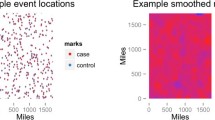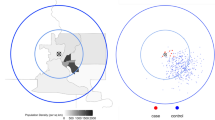Abstract.
Based on a four-point evaluation system consisting of accuracy, consistency, power, and chance to commit type I errors, this study compares Tango's minimum p (MinP) and Stone's maximum relative risk (MaxRR) methods for detecting focused cluster size through simulations in GIS. It reveals that the MinP method is more effective than the MaxRR method. The MinP method exhibits higher levels of accuracy and consistency; and its power and chance to commit type I errors are similar to the MinP method. The MaxRR method has a tendency to underestimate the cluster size, while the MinP method tends to overestimate the cluster size, particularly when the clusters are relatively big and have high relative risk levels. In addition, the MinP method seems to be most effective in revealing the size of clusters when clusters are neither too strong nor too weak. The lowest detection rates for clustering occur when the clustering signal is relatively weak, which is easily understandable. In practice, it might be useful to use both the methods to estimate a range of possible cluster sizes, where the MaxRR method indicates the lower estimate, while the MinP method gives the higher estimate of the cluster size.
Similar content being viewed by others
Author information
Authors and Affiliations
Additional information
Received: 24 August 2002 / Accepted: 20 December 2002
Rights and permissions
About this article
Cite this article
Sun, Y. Determining the size of spatial clusters in focused tests: Comparing two methods by means of simulation in a GIS. J Geograph Syst 4, 359–370 (2002). https://doi.org/10.1007/s101090300094
Issue Date:
DOI: https://doi.org/10.1007/s101090300094




